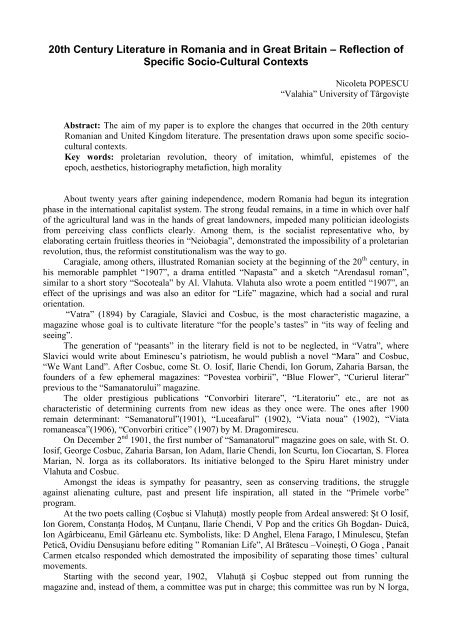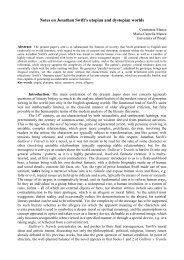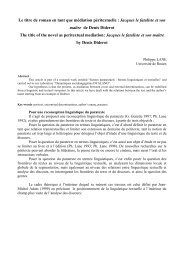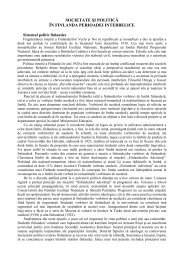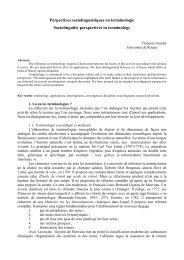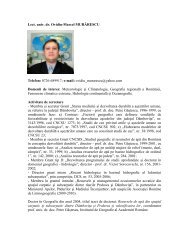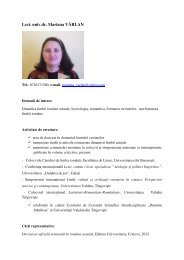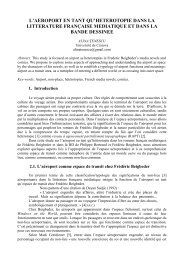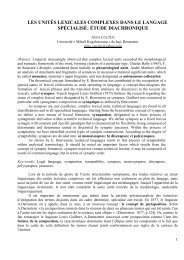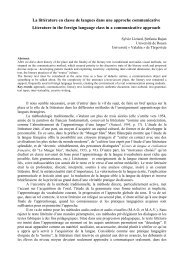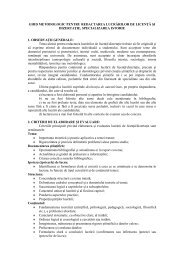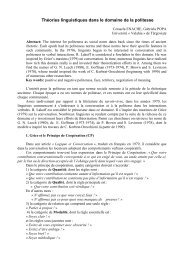20th Century Literature in Romania and in Great Britain â Reflection ...
20th Century Literature in Romania and in Great Britain â Reflection ...
20th Century Literature in Romania and in Great Britain â Reflection ...
Create successful ePaper yourself
Turn your PDF publications into a flip-book with our unique Google optimized e-Paper software.
<strong>20th</strong> <strong>Century</strong> <strong>Literature</strong> <strong>in</strong> <strong>Romania</strong> <strong>and</strong> <strong>in</strong> <strong>Great</strong> Brita<strong>in</strong> – <strong>Reflection</strong> ofSpecific Socio-Cultural ContextsNicoleta POPESCU“Valahia” University of TârgovişteAbstract: The aim of my paper is to explore the changes that occurred <strong>in</strong> the <strong>20th</strong> century<strong>Romania</strong>n <strong>and</strong> United K<strong>in</strong>gdom literature. The presentation draws upon some specific socioculturalcontexts.Key words: proletarian revolution, theory of imitation, whimful, epistemes of theepoch, aesthetics, historiography metafiction, high moralityAbout twenty years after ga<strong>in</strong><strong>in</strong>g <strong>in</strong>dependence, modern <strong>Romania</strong> had begun its <strong>in</strong>tegrationphase <strong>in</strong> the <strong>in</strong>ternational capitalist system. The strong feudal rema<strong>in</strong>s, <strong>in</strong> a time <strong>in</strong> which over halfof the agricultural l<strong>and</strong> was <strong>in</strong> the h<strong>and</strong>s of great l<strong>and</strong>owners, impeded many politician ideologistsfrom perceiv<strong>in</strong>g class conflicts clearly. Among them, is the socialist representative who, byelaborat<strong>in</strong>g certa<strong>in</strong> fruitless theories <strong>in</strong> “Neiobagia”, demonstrated the impossibility of a proletarianrevolution, thus, the reformist constitutionalism was the way to go.Caragiale, among others, illustrated <strong>Romania</strong>n society at the beg<strong>in</strong>n<strong>in</strong>g of the 20 th century, <strong>in</strong>his memorable pamphlet “1907”, a drama entitled “Napasta” <strong>and</strong> a sketch “Arendasul roman”,similar to a short story “Socoteala” by Al. Vlahuta. Vlahuta also wrote a poem entitled “1907”, aneffect of the upris<strong>in</strong>gs <strong>and</strong> was also an editor for “Life” magaz<strong>in</strong>e, which had a social <strong>and</strong> ruralorientation.“Vatra” (1894) by Caragiale, Slavici <strong>and</strong> Cosbuc, is the most characteristic magaz<strong>in</strong>e, amagaz<strong>in</strong>e whose goal is to cultivate literature “for the people’s tastes” <strong>in</strong> “its way of feel<strong>in</strong>g <strong>and</strong>see<strong>in</strong>g”.The generation of “peasants” <strong>in</strong> the literary field is not to be neglected, <strong>in</strong> “Vatra”, whereSlavici would write about Em<strong>in</strong>escu’s patriotism, he would publish a novel “Mara” <strong>and</strong> Cosbuc,“We Want L<strong>and</strong>”. After Cosbuc, come St. O. Iosif, Ilarie Chendi, Ion Gorum, Zaharia Barsan, thefounders of a few ephemeral magaz<strong>in</strong>es: “Povestea vorbirii”, “Blue Flower”, “Curierul literar”previous to the “Samanatorului” magaz<strong>in</strong>e.The older prestigious publications “Convorbiri literare”, “Literatoriu” etc., are not ascharacteristic of determ<strong>in</strong><strong>in</strong>g currents from new ideas as they once were. The ones after 1900rema<strong>in</strong> determ<strong>in</strong>ant: “Semanatorul”(1901), “Luceafarul” (1902), “Viata noua” (1902), “Viataromaneasca”(1906), “Convorbiri critice” (1907) by M. Dragomirescu.On December 2 nd 1901, the first number of “Samanatorul” magaz<strong>in</strong>e goes on sale, with St. O.Iosif, George Cosbuc, Zaharia Barsan, Ion Adam, Ilarie Chendi, Ion Scurtu, Ion Ciocartan, S. FloreaMarian, N. Iorga as its collaborators. Its <strong>in</strong>itiative belonged to the Spiru Haret m<strong>in</strong>istry underVlahuta <strong>and</strong> Cosbuc.Amongst the ideas is sympathy for peasantry, seen as conserv<strong>in</strong>g traditions, the struggleaga<strong>in</strong>st alienat<strong>in</strong>g culture, past <strong>and</strong> present life <strong>in</strong>spiration, all stated <strong>in</strong> the “Primele vorbe”program.At the two poets call<strong>in</strong>g (Coşbuc si Vlahuţă) mostly people from Ardeal answered: Şt O Iosif,Ion Gorem, Constanţa Hodoş, M Cunţanu, Ilarie Chendi, V Pop <strong>and</strong> the critics Gh Bogdan- Duică,Ion Agârbiceanu, Emil Gârleanu etc. Symbolists, like: D Anghel, Elena Farago, I M<strong>in</strong>ulescu, ŞtefanPetică, Ovidiu Densuşianu before edit<strong>in</strong>g ” <strong>Romania</strong>n Life”, Al Brătescu –Vo<strong>in</strong>eşti, O Goga , PanaitCarmen etcalso responded which demostrated the imposibility of separat<strong>in</strong>g those times’ culturalmovements.Start<strong>in</strong>g with the second year, 1902, Vlahuţă şi Coşbuc stepped out from runn<strong>in</strong>g themagaz<strong>in</strong>e <strong>and</strong>, <strong>in</strong>stead of them, a committee was put <strong>in</strong> charge; this committee was run by N Iorga,
an impulsive person with strong op<strong>in</strong>ions regard<strong>in</strong>g art’s <strong>and</strong> culture’s nationalism, a forcefulopponent of the idea of copy<strong>in</strong>g the West. He was a follower of the poetry that could be understoodby everybody <strong>and</strong> a supporter of the pr<strong>in</strong>cely past.In 1905 N Iorga became the official director of the magaz<strong>in</strong>e. In his “History of contemporary<strong>Romania</strong>n literature” he saw himself as an adept of the “Semănătorii” movement (<strong>Romania</strong>ncultural movement that emphasized the problems of Peasantry). In N Iorga’s series of articlespublicized between 1899 <strong>and</strong> 1904 he had preached aga<strong>in</strong>st the foreign <strong>in</strong>fluences <strong>in</strong> literature <strong>and</strong>culture st<strong>and</strong><strong>in</strong>g for national feel<strong>in</strong>gs <strong>and</strong> encourag<strong>in</strong>g the promotion of Peasantry. Iorgaemphasized utopically the national cultural factor <strong>and</strong> supported a the social progress that couldhappen only after a brotherhood was made between all <strong>Romania</strong>ns regard<strong>in</strong>g of their social status.As a start<strong>in</strong>g po<strong>in</strong>t, the “Semănatori” movement fought aga<strong>in</strong>st some exaggeratedcosmopolitan trends; they also draw attention upon the importance of national values when creat<strong>in</strong>ga culture. The magaz<strong>in</strong>e succeeded <strong>in</strong> gather<strong>in</strong>g around it a lot of people from Ardeal; when do<strong>in</strong>gthis it also helped them become closer to the cultural movement from the other side of themounta<strong>in</strong>s <strong>and</strong> make a brotherhood between the <strong>in</strong>tellectuals who had fought for re-unit<strong>in</strong>gTransilvania with the rest of <strong>Romania</strong> that was to happen immediately after war.In the years that followed the First World War, <strong>Romania</strong>’s social <strong>and</strong> economical life sufferedmultiple changes that were determ<strong>in</strong>ed by the numerous factories which stopped their activity. Thiswas caused by the lack <strong>in</strong> labor force especially <strong>in</strong> agriculture. All these contributed to a decrease <strong>in</strong>production <strong>and</strong> trade was also badly affected.The <strong>in</strong>ternal policy could be described as an important contradiction between work<strong>in</strong>g class<strong>and</strong> aristocracy, between Peasantry <strong>and</strong> l<strong>and</strong>owners.A feel<strong>in</strong>g of chang<strong>in</strong>g the era’s climate appeared as a consequence of these transformationsthe occurred among different levels of the social organization. Thus, the two World Wars (1914-1918 <strong>and</strong> 1939-1945) marked some serious social crises that took place <strong>in</strong> the first half of the <strong>20th</strong>century. The <strong>Great</strong> Union from 1918 was someth<strong>in</strong>g that was bound to happen as it was one of thegreatest hopes of the <strong>Romania</strong>n people that sacrificed a lot <strong>in</strong> war.The Agricultural Reform (1921) had a great <strong>in</strong>fluence because the soldiers from Mărăşeşti,their widows <strong>and</strong> children were given l<strong>and</strong> <strong>and</strong> <strong>Romania</strong> became a country of contrasts: Westernluxury of the dom<strong>in</strong>eer<strong>in</strong>g classes next to the poverty of the many of the work<strong>in</strong>g class <strong>and</strong> thePeasantry, the superficial <strong>and</strong> rapid modernasation of the capital city <strong>and</strong> the retrogression ofvillages. ( <strong>Romania</strong>’s History).Due to these circumstances the literary activity of that times was divers <strong>and</strong> contradictory.World War First <strong>in</strong>terrupted the writ<strong>in</strong>g activity for some years, books were no longerpublished, magaz<strong>in</strong>es stopped appear<strong>in</strong>g: “Semanatorul” died out, the build<strong>in</strong>g which housed “ The<strong>Romania</strong>n Life” was burnt down <strong>in</strong> 1916, the literary meet<strong>in</strong>gs ceased.These are years when writers who had ma<strong>in</strong> roles <strong>in</strong> the prewar literary movement died:Şt. O. Iosif <strong>in</strong> 1913, Coşbuc <strong>in</strong> 1918, Vlahuţã <strong>in</strong> 1920.However, the <strong>in</strong>terbelic age of <strong>Romania</strong>n literature is “an age full of so much creative tumult”( Ion Rotaru. “A history of <strong>Romania</strong>n literature” vol. II ) extend<strong>in</strong>g connections with otherliteratures., try<strong>in</strong>g to rise above the somewhat prov<strong>in</strong>cial spirit, head<strong>in</strong>g for universal plans ofaffirmation. The ma<strong>in</strong> pursuit of “europeanism ” <strong>and</strong> at the same time of th revaluation of thenational orig<strong>in</strong>ality results from this tendency, <strong>and</strong> it stamps to the <strong>in</strong>terbelic spiritual life (O.Crohmãlniceanu, “<strong>Romania</strong>n literature between the two World Wars“ ).The diversity of roles <strong>and</strong> literary trend is also impressive. “The <strong>Romania</strong>n Life” trendpromotes a realistic literature, develop<strong>in</strong>g the great clasics’ literature, encourag<strong>in</strong>g democracy <strong>and</strong>the national characteristics.. E.Lov<strong>in</strong>escu’s literary ideology, who founded “The Demon Lover“ <strong>in</strong>1919, is called modernism <strong>and</strong> has as a st<strong>and</strong>po<strong>in</strong>t the simple theory of imitation, taken from theFrench psychologist Gabriel Tarde accord<strong>in</strong>g to whom, as a child immitates a grown up, thepeasant immitates the merchant, the primitive man immitates the civilized one, <strong>in</strong> the same way theuncivilized people imitate the advanced ones. “ The Demon Lover “ represents for <strong>Romania</strong>n
literature a large <strong>and</strong> rapid adoption of the latest artistical means from West, that is its connectionwith the “age spirit “, struggl<strong>in</strong>g aga<strong>in</strong>st Titu Maiorescu’s art for art’s sake.“The Demon Lover“ is the rocket launcher of some personalities who will have <strong>and</strong> impacton literature. Never before had <strong>Romania</strong>n literature had so many famous representatives (Sadoveanu, Arghezi, Blaga, Ion Barbu, E.Lov<strong>in</strong>escu, H. Papadat-Bengescu, Mateiu Caragiale,Tudor Vianu,G. Cãl<strong>in</strong>escu, Camil Petrescu, Ion Pillat ), never before had it gone through a lovlier<strong>in</strong>cl<strong>in</strong>ation to argue about the values. The panorama of the writers’ activity represents, therefore, anample variety <strong>and</strong> complexity, supplement<strong>in</strong>g from a compact texture of lights <strong>and</strong> <strong>in</strong>tense shadow.In this context <strong>Romania</strong>n fiction is ever head<strong>in</strong>g for solid epic constructions, <strong>and</strong> the novel isthe one to reach its greateste fullfilments. Although <strong>Romania</strong>n literature conf<strong>in</strong>ed the appearance ofthe first proper novel <strong>in</strong> the publication of N. Filimon “Ciocoii vechi şi noi” <strong>in</strong> 1863, 1920 is alsoan important moment <strong>in</strong> <strong>Romania</strong>n novel’s modernization. After a long period of elaboration, LiviuRebreanu’s novel “Ion“ comes out <strong>and</strong> is enthusiastically welcomed by E. Lov<strong>in</strong>escu: “thework solves a problem <strong>and</strong> puts an end to controversy”, the first objective novel which sends<strong>Romania</strong>n literature to the European value.The urban theme proposed by Lov<strong>in</strong>escu <strong>in</strong> his program has not been dealt with yet. In thisnovel, Rebreanu conjures up the rural society from Ardeal, at the beg<strong>in</strong>n<strong>in</strong>g of the 20 th century,although he doesn’t present the peasant who had stepped back from the civilization, like Sadoveanu,but his desire of enrichment, the l<strong>and</strong> be<strong>in</strong>g the nucleus of all dest<strong>in</strong>ies.In this society, where social position <strong>and</strong> respect are measured <strong>in</strong> the plot of l<strong>and</strong> you own, thewoman is noth<strong>in</strong>g but a bearer of fortune.Ion, the ma<strong>in</strong> character, is the son of a peasant who was not able to keep the fortune, <strong>and</strong> triesto buy back the plots of l<strong>and</strong> that his father had sold. The only option is the marriage with a richgirl. Therefore, Ana, daughter of Vasile Baciu, the ugly, but rich girl, becomes a way to put an endto poverty for him. “Silent <strong>and</strong> mistreated nature, dest<strong>in</strong>ed to suffer<strong>in</strong>g”, Ana didn’t have hermother, <strong>and</strong> the love of her father was “whimful”. Lonely, shy, “her soul is long<strong>in</strong>g for a coy, deeplove” (Ion, Liviu Rebreanu).About the social condition of women <strong>in</strong> the village, G. Cal<strong>in</strong>escu says: “In the rural society,the woman represents two work<strong>in</strong>g h<strong>and</strong>s, a fortune <strong>and</strong> a child breeder. The erotic crisis be<strong>in</strong>gsurpassed, she ceases to signify someth<strong>in</strong>g by her fem<strong>in</strong><strong>in</strong>ity. Ana’s fate is even worse, but muchmore different from the fate of any other country woman” (The History of the <strong>Romania</strong>n <strong>Literature</strong>from the orig<strong>in</strong>s up to the present, G. Cal<strong>in</strong>escu).The <strong>Romania</strong>n novel starts us<strong>in</strong>g the city as its proper sett<strong>in</strong>g <strong>and</strong> its <strong>in</strong>itiator is HortensiaPapadat-Bengescu, “the one who uses psycho-analytical literature” (O. Crohmalniceanu).“The high society” of the capital, made up of snobs <strong>and</strong> less genu<strong>in</strong>e aristocrats, whosefeatures are exaggeratedly stressed, is presented <strong>in</strong> “The Cycle of Hallips”, from which the novel“Bach Music Concert”, the second cycle, is thought to be the best. If with Rebreanu, the woman isnoth<strong>in</strong>g but “a bearer of fortune”, with Hortensia Papadat-Bengescu, the woman is concerned withsocial relations, with what “the world would say”. “A characteristic aspect of this world is thatpeople are preoccupied with money only at the beg<strong>in</strong>n<strong>in</strong>g, when jo<strong>in</strong><strong>in</strong>g the upper class. All of themare more or less rich, but with no f<strong>in</strong>ancial concern. Fortune is the only environment <strong>in</strong> which thesetranslucent be<strong>in</strong>gs can walk (…). They are not politically ambitious; it is not about fortune, norabout speculators, but about persons preoccupied with what , be<strong>in</strong>g keen onthrow<strong>in</strong>g danc<strong>in</strong>g parties, on be<strong>in</strong>g received to certa<strong>in</strong> receptions, on react<strong>in</strong>g <strong>in</strong> every moment oftheir lives, even <strong>in</strong> the most serious, or <strong>in</strong> the most dist<strong>in</strong>guished” (G. Cal<strong>in</strong>escu).Elena <strong>and</strong> eng<strong>in</strong>eer Drăgănescu represent one of the couples whose dest<strong>in</strong>ies are built with<strong>in</strong>the novel. Elena Drăgănescu is the first daughter of Leonora <strong>and</strong> Doru Drăgănescu <strong>and</strong> she is madeof two psychological areas: Elena is <strong>in</strong> love with Maxenţiu, whom she gets engaged with, but herstep sister, Mika- Lé, master <strong>in</strong> the art of do<strong>in</strong>g harm, brutally <strong>in</strong>terferes with<strong>in</strong> the two lovers.Elena brakes her engagement, “with cold blood as stubborn as immovable had been her wish tomarry him”( H. P. Bengescu, “Bach music concert”). The other area contures up her exceptionalcapacity of gett<strong>in</strong>g <strong>in</strong>volved <strong>in</strong> the organization of receiv<strong>in</strong>g guests at different social events, which
she used to <strong>in</strong>itiate <strong>in</strong> her budoires. “Elena, used from a very young age to be a hostess <strong>in</strong> herparental house, had easily built her social relationships. Her snobbery made har choose what wasbest <strong>and</strong> she received everybody with the same natural reserve. As they had for her only the qualityof guests, she would treat them equally <strong>and</strong> would dom<strong>in</strong>ate without any effort (…). However, ather receptions one didn`t talk either politics or bus<strong>in</strong>ess” (ibidem).The analytic novel is also tackled by Camil Petrescu, a writer with a taste for philosophy, anature of lucid artist, <strong>in</strong>cl<strong>in</strong>ed to theorize his beliefs.Published three years after the novel “Bach music concert”, <strong>in</strong> 1930, the subjective novel “Thelast night of love, the first night of war” catches the drama of the lucid <strong>in</strong>telectual, <strong>in</strong> want of theultimate love feel<strong>in</strong>g, dom<strong>in</strong>ated by uncerta<strong>in</strong>ties, who saves himself through the underst<strong>and</strong><strong>in</strong>g of amore powerful drama, that of the humanity that lives the tragism of an absolute war, seen as animm<strong>in</strong>ence of death.In <strong>Great</strong> Brita<strong>in</strong>, dur<strong>in</strong>g the Victorian Age, troubled by profound social restlessness, a wavewhich kept the people from see<strong>in</strong>g the realities of life, spread. The only man of culture whosucceeded <strong>in</strong> tear<strong>in</strong>g apart this wave was Thomas Hardy. Ow<strong>in</strong>g to this th<strong>in</strong>g he was always treatedbadly <strong>and</strong> criticized by his contemporaries, who could not underst<strong>and</strong> <strong>and</strong> accept this writer`scharacters who represented a defy<strong>in</strong>g of all the values which used to circulate <strong>in</strong> that epoch. Ahundred years later another writer asserted himself, writer who profoundly admired this period <strong>and</strong>openly declared his curtsey towards the Victorian “outcast” <strong>in</strong> an honest attempt to def<strong>in</strong>e his ownmanner of writ<strong>in</strong>g. Fowel`s attitude.S<strong>in</strong>ce it is about this writer, compared to Hardy <strong>and</strong> to the world <strong>in</strong> which he lived, it wasdeclared by the writer <strong>in</strong> many of the <strong>in</strong>terviews he gave, <strong>in</strong>terviews which even conta<strong>in</strong>ed reveal<strong>in</strong>gabout the way he began to write his famous novel after he contemplated for hours on stretch theimage of a mysterious woman who was sitt<strong>in</strong>g on a lonely cliff <strong>and</strong> was star<strong>in</strong>g at the seascape. Hedeclared:“The woman’s figure couldn’t be seen <strong>and</strong> she didn’t show any gra<strong>in</strong> of sexuality. But she wasa Victorian; because I always saw her <strong>in</strong> the same still posture with her back at the world <strong>and</strong> herface towards the whirl<strong>in</strong>g sea, it seemed to represent some k<strong>in</strong>d of mute reproach addressed to theVictorian epoch. She seemed doomed. I didn’t know what crime she had committed but I wanted toprotect her. Thus I fell <strong>in</strong> love with her or with her way of sitt<strong>in</strong>g for hours on stretch look<strong>in</strong>g at asteady spot towards the sea. I didn’t know what the truth was” ( John Fowles “Notes on anunf<strong>in</strong>ished novel”)This testimony is relevant because it clearly illustrates Fowles’s paradoxical attitude: thesentimental attachment towards the values of an age <strong>and</strong> towards the modernist <strong>and</strong> post-modernistrebellion aga<strong>in</strong>st of old values of the same time, this paradox of Fowles’ was the ma<strong>in</strong> target <strong>and</strong>source of many debates both literary <strong>and</strong> nonliterary.Consciously, putt<strong>in</strong>g himself, “<strong>in</strong> the shadow of Thomas Hardy”, as he declared, Fawlesoutl<strong>in</strong>es the relationship between the fiction of the Victorian author so appreciated <strong>and</strong> his own. Ifwe th<strong>in</strong>k of the fact that the writer belongs to a deeply rebel time, which contested all traditionalvalues, we will see that we cannot expect an attitude entirely humbled towards the fiction ofThomas Hardy <strong>and</strong> we will also see, that he will not follow dutifully the steps of his greatpredecessor. However it seems that Thomas Hardy’s shadow hangs over Fowles novels <strong>and</strong> exertsan important <strong>in</strong>fluence not only on the surface but also on their depth; the similarities which existbetween these two authors, although they can be considered relative by many people, at the level ofsome significant images, at the level of certa<strong>in</strong> visions on man <strong>and</strong> nature, there are some visionswhich represent dilemmas existentistically placed at the base of human life.Tak<strong>in</strong>g <strong>in</strong>to account the fact that between the two authors lie various differences start<strong>in</strong>g withthe temporal <strong>and</strong> literary ones <strong>and</strong> f<strong>in</strong>ish<strong>in</strong>g with the philosophical ones, yet there can be possiblean analysis of the resemblances between the two, similarities which consist <strong>in</strong> common ideas aboutthe society <strong>and</strong> the time <strong>in</strong> which they have <strong>in</strong> consideration.
Such an analysis has as start<strong>in</strong>g po<strong>in</strong>t the novel “The French Lieutenant’s Women”, novelwhich can be considered to be a “Victorian novel with<strong>in</strong> a novel” because it follows the recreationof the atmosphere of the English society at the half of n<strong>in</strong>eteenth century by the ironic view of awriter from the twentieth century.On the one h<strong>and</strong>, the novel follows all the Victorian concepts <strong>and</strong> the love story develops <strong>in</strong>an ideal Victorian way <strong>in</strong> the sense that it follows the traditional one, of love, of desire, but mostlythe way of duty seen as supreme <strong>in</strong> those times. Everyth<strong>in</strong>g must be subord<strong>in</strong>ated to duty. GetaDimitriu, <strong>in</strong> her debates on Fowles, gathered <strong>in</strong> “The path to fulfillment: Daniel Mart<strong>in</strong>”, hasnoticed the same th<strong>in</strong>g, which is the fact that: “the concepts he uses <strong>in</strong> realiz<strong>in</strong>g the Victorian novelare <strong>in</strong>timately connected to the epistemes of the epoch” (Geta Dimitriu, “The path to fulfillment:Daniel Mart<strong>in</strong>”, p.5). The narrative is <strong>in</strong> the third person, lett<strong>in</strong>g the narrator be noticed <strong>in</strong>everyth<strong>in</strong>g he narrates <strong>and</strong> is part of the common illusion that he controls the characters, the action<strong>and</strong> the atmosphere.This sudden <strong>in</strong>trusion <strong>in</strong> the apparently l<strong>in</strong>ear plot of the “spy who is adjust<strong>in</strong>g his telescope”,a spy who identifies himself with the contemporary author, seen as an almighty puppeteer, with fullrights over his characters, is more than a postmodernist way of stress<strong>in</strong>g the fictional character ofthe novel. Fowles’ art lies <strong>in</strong> his ability of h<strong>and</strong>l<strong>in</strong>g the literary techniques of the n<strong>in</strong>eteenth <strong>and</strong>twentieth centuries but also, it lies <strong>in</strong> the fact that he always rem<strong>in</strong>ds the reader that “both theepistemological suppositions <strong>and</strong> the aesthetic concepts on which the Victorian novel is based areestablished from the epistemes <strong>and</strong> the aesthetics of his time “(ibidem, p.6). These contradictorysuppositions can not be considered as part of different epochs but, as part of the same epoch: theVictorian one. This mixture of Victorian <strong>and</strong> postmodernist techniques is found <strong>in</strong> Fowles’declaration which states that “each Victorian had two identities”, <strong>and</strong> the best guide of the epoch isDoctor Jekyll <strong>and</strong> Mister Hyde’s story, as one <strong>and</strong> the same person, but with dist<strong>in</strong>ct identities. So,this epoch, <strong>in</strong> modernist writers’ vision, presented a fatal separation which could be found <strong>in</strong> everyhuman be<strong>in</strong>g. On the one h<strong>and</strong>, there is the respect for social concepts <strong>and</strong>, on the other h<strong>and</strong>,<strong>in</strong>temperate torrents of th<strong>in</strong>gs like adventure, love, romance <strong>and</strong> passion, th<strong>in</strong>gs completelyforbidden <strong>in</strong> the Victorian epoch, with one notable exception: Thomas Hardy’s novels.Even the double end of the novel, although entirely modern <strong>in</strong> its uncerta<strong>in</strong> hesitation betweenthe two alternatives, is faithful to the Victorians Dr. Jekyll <strong>and</strong> Mr. Hyde, as the author describedthem <strong>in</strong> his book. The first end<strong>in</strong>g, represented by Charles <strong>and</strong> Ernest<strong>in</strong>e’s reunion, is stronglyconnected to the Victorians fear of uncerta<strong>in</strong>ty <strong>and</strong>, at the same time, it seems like a joke made byFowles, which is related to Victorian end<strong>in</strong>gs. For example, the f<strong>in</strong>al marriage of Clym’s cous<strong>in</strong> toVenn clearly ends the novel “The return of the Native”, an end<strong>in</strong>g full of falsity but, necessary forthe society’s concepts, a society <strong>in</strong> which Thomas Hardy lived <strong>and</strong> wrote, the author of the abovementioned novel. The end is there even though the writer was perfectly conscious that it is just afalse denouement of the narrated events.The second end<strong>in</strong>g looks like a mirror <strong>in</strong> which is reflected the true image of the protagonists,especially because this end<strong>in</strong>g is less subord<strong>in</strong>ated to negatives, it is more opened <strong>and</strong> therefore,more modern but, at the same time, it characterizes Fowles <strong>and</strong> his entire work <strong>and</strong>, paradoxically,it seems more Victorian because it has deep essential <strong>in</strong>volvements. Each end<strong>in</strong>g of the novel givesthe opportunity of a retrospective which despite its clarity, it is not the complete image of the events<strong>and</strong> their implications. This sense of unclear perspectives expla<strong>in</strong>s why Fowles has been sopreoccupied with the historic time <strong>in</strong> the novel. His attitude towards history <strong>and</strong>, implicit, the realityit is presented under the shape of a conscience which belongs to the present, thus, transform<strong>in</strong>g thenovel <strong>in</strong>to a “historiography metafiction” (L<strong>in</strong>da Hutcheon’s conception <strong>and</strong> terms). This selfconsciousness might be regarded as the ma<strong>in</strong> narrative strategy used by Fowles <strong>in</strong> the novel, whichis a def<strong>in</strong><strong>in</strong>g characteristic that dist<strong>in</strong>guishes him from his Victorian predecessors.The novel is set <strong>in</strong> certa<strong>in</strong> time <strong>and</strong> real place, Engl<strong>and</strong> <strong>in</strong> March 1867, eight years afterCharles Darw<strong>in</strong>’s “The orig<strong>in</strong> of species” was published <strong>and</strong> six months before Karl Marx <strong>in</strong>tendedto publish his first volume of “Das Kapital”. Fowles does not show a stable Victorian society, butone that looks that way because the society, apparently, had long-used values <strong>and</strong> ways of action,
ut it was actually consumed by a lot of <strong>in</strong>ner contradictions which he hadn’t the courage to expressdirectly because of fear of be<strong>in</strong>g isolated from the rest of the society. The same Hardy felt this <strong>in</strong>nercorrosiveness that makes members of his society restless, so the same Fowles knew to perceive thisenergy materialized under the shape of some ideas <strong>and</strong> feel<strong>in</strong>gs that were go<strong>in</strong>g to destroy it. Thesame way the sea erodates Lyme Bay’s shore, central sett<strong>in</strong>g of the novel, <strong>in</strong> the same way theVictorian world is eaten <strong>in</strong>side. If at Hardy this th<strong>in</strong>g was pure genial <strong>in</strong>tuition, at Fowles the way<strong>and</strong> the force with which the past <strong>and</strong> the future m<strong>in</strong>gle with the present are part of some modernconsciousness which triggers <strong>in</strong>dividual <strong>and</strong> makes one feel powerless when confront<strong>in</strong>g with time.Hence, basic concept of modernists is allow<strong>in</strong>g human personality to express itself as the way it is,the only one which can save the human be<strong>in</strong>g when confront<strong>in</strong>g with transient human condition.Fowles knows that an epoch is not monolithic, but conta<strong>in</strong>s discont<strong>in</strong>uous forces which arepermanent struggle, forces which come both from the past <strong>and</strong> are not perfectly <strong>in</strong>tegrated <strong>in</strong>present, but also from the future which will earlier explode <strong>and</strong> will make the present becomefuture.The ma<strong>in</strong> character <strong>in</strong> Sarah Woodruff, The woman <strong>in</strong> the title, named “The Tragedy” or othernames such as “the French Lieutenant’s Whore”, a name which , <strong>in</strong> the vision of the “pure fellows”who surround her, is appropriate <strong>and</strong> won’t have to much to do with her. She lives <strong>in</strong> the LymeRegis town be<strong>in</strong>g known as a dishonored woman because of the fact that she was seduced <strong>and</strong>ab<strong>and</strong>oned by a certa<strong>in</strong> French sailor who would have returned to France <strong>and</strong> married anotherwoman.Sarah, who represents the extra-narrative reality <strong>and</strong> the attempt at not be<strong>in</strong>g categorized, isalways present on the mysterious ways of the town avoid<strong>in</strong>g the company of the others whoconstantly give her the same guidel<strong>in</strong>es they follow <strong>and</strong> always rem<strong>in</strong>d her not to take the path ofperdition. She is also the one who leads Charles through these unofficial ways, but he fears ofdisobey<strong>in</strong>g the laws which could br<strong>in</strong>g alienation to his fellows, even though this is represented byphysical isolation. He can’t seem to divide the true values of the human soul <strong>and</strong> to dist<strong>in</strong>guish thestrict <strong>and</strong> absurd rules.John Fowles perception about the Victorians was actually expla<strong>in</strong>ed by himself: “ Until 1860the great steel structures of their philosophies, their religious <strong>and</strong> social stratifications began to lookdangerously loose”. But all didn’t mean that society would noticeably beg<strong>in</strong> to fall. On the contraryFowles himself reassures: “ In 1867 the epoch seems monolithic <strong>in</strong> its smallest details: snobbery is<strong>in</strong> the period of maximum prosperity, the wealthy philist<strong>in</strong>es are more decided than ever to keep thework<strong>in</strong>g class to her place <strong>and</strong> the morality was extremely rigorous” ( John Fowles, “Notes on anunf<strong>in</strong>ished novel”)Like the majority of people belong<strong>in</strong>g to the 20 th century, Fowles often laughs at the hypocrisyof this “high morality” <strong>and</strong> the satire of the 19 th century is to be even more profound <strong>and</strong> namely,the presumptions that the epoch makes without any clear proof. But above all this, the author iscapable of admir<strong>in</strong>g the Victorian culture <strong>in</strong> moral terms. He appreciates his strong sense of humanf<strong>in</strong>ality, its determ<strong>in</strong>ation of mak<strong>in</strong>g life purposeful, because he is profoundly conscious that hiselements are miss<strong>in</strong>g from his epoch.Work<strong>in</strong>g <strong>in</strong> the same tradition as Swift, Sterne, Nabokov, Robbe-Grillet, Fowles discoveredthat his way of tackl<strong>in</strong>g is that of a meta-novel. His ironic digressions which make the reader gettrust <strong>in</strong> himself, the image that he creates about the author seen as a manipulator of his fictitiouscharacters, the conscious rendition of the pa<strong>in</strong> he has been through, then, when he wrote his book,keeps him away so much from Hardy <strong>and</strong> his style of writ<strong>in</strong>g. However, as we could see, thesimilarities between two authors are somewhere <strong>in</strong> the depth of those “sacred truths of the humansoul”) that both try to reflect <strong>in</strong> their works.The “French writer” from Fowles narrative suggests the source of ideas <strong>and</strong> experiment from“ The French Lieutenant’s Woman” <strong>and</strong> from other recent English novels. From Proust <strong>and</strong> Gride,the “lessons of the existential philosophy” mentioned by Fowles, from the atmosphere of the “epochof Ala<strong>in</strong> Robbe-Grillet <strong>and</strong> Ronald Barthes”, the author confesses his source of his prose. In thelight of these th<strong>in</strong>gs, the title chosen by the author is not at all accidental. Naturally,
the lover can be only of a French, tak<strong>in</strong>g <strong>in</strong>to consideration the writer’s preference for Frenchliterature.However, irrespective of the <strong>in</strong>fluences the novelist got, irrespective of the way he adhered tothe theoretical suggestions of postmodern epoch <strong>and</strong> of what he rejected from these, Fowles wrote anovel full of brilliance with a historical background drawn with m<strong>in</strong>uteness <strong>and</strong> on whichmysterious, strange characters are projected. A potential love story, an epic construction of acharm<strong>in</strong>g lyrical quality.BIBLIOGRAPHY1. Bart, John, „Postmodernismul revăzut”, Stuttgart, 1985.2. Bradbury, Malcolm, „Postmodernism”, Stuttgart, 1993.3. Christiani Brown, Ruth „Iubita locotenentului francez – Ecouri şi răspunsuri”, în„Studii moderne”, 1985.4. Crohmălniceanu, Ovidiu, „Literatura română între cele două războaie mondiale”,vol. I, Editura Didactică şi Pedagogică, Bucureşti, 1982, p. 13.5. Dimitriu, Geta, „Calea spre împl<strong>in</strong>ire: Daniel Mart<strong>in</strong>”, în Miroiu Mihai (ed.),„Literatura engleză postmodernă”, 1988.6. Ford, Boris (ed.), „Ghidul pelican al literaturii engleze”, ed. Pengu<strong>in</strong>, 1990.7. Fowles, John, „Note asupra unui roman neterm<strong>in</strong>at”, în „Romanul astăzi”, Fontana,1977.8. Istoria românilor.9. Papadat-Bengescu, Hortensia, „Concert d<strong>in</strong> muzică de Bach”, Editura Gramar, Bucureşti,2000, p. 75.10. Rebreanu Liviu, „Ion”, Editura pentru Literatură, Bucureşti, 1967, p. 157.11. Rotaru, Ion, „O istorie a literaturii române”, vol. II, Editura M<strong>in</strong>erva, Bucureşti,1971, p. 230.12. Scruggs, Charles, „Cele două f<strong>in</strong>aluri ale romanului « Iubita locotenentuluifrancez »” în „Studii literare postmoderne”, 1985.13. Stevenson, R<strong>and</strong>all, „Romanul britanic d<strong>in</strong> anii 30”, Iaşi, Institutul European, 1993.


